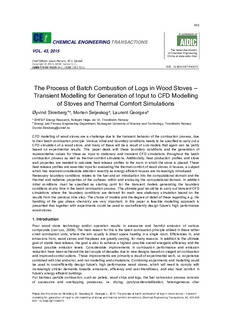| dc.contributor.author | Skreiberg, Øyvind | |
| dc.contributor.author | Seljeskog, Morten | |
| dc.contributor.author | Georges, Laurent | |
| dc.date.accessioned | 2017-12-13T10:03:09Z | |
| dc.date.available | 2017-12-13T10:03:09Z | |
| dc.date.created | 2015-06-26T14:49:29Z | |
| dc.date.issued | 2015 | |
| dc.identifier.citation | Chemical Engineering Transactions. 2015, 43 433-438. | nb_NO |
| dc.identifier.issn | 1974-9791 | |
| dc.identifier.uri | http://hdl.handle.net/11250/2471078 | |
| dc.description.abstract | CFD modelling of wood stoves are a challenge due to the transient behavior of the combustion process, due to their batch combustion principle. Various initial and boundary conditions needs to be specified to carry out a CFD simulation of a wood stove, and many of these will be a result of sub-models that again can be partly based on experimental results. This paper deals with these boundary conditions and the generation of representative values for these as input to stationary and transient CFD simulations throughout the batch combustion process as well as thermal comfort simulations. Additionally, heat production profiles and stove wall properties are needed to calculate heat release profiles to the room in which the stove is placed. These heat release profiles are essential input for evaluating the thermal comfort of wood stoves in houses, a subject which has received considerable attention recently as energy efficient houses are increasingly introduced. Necessary boundary conditions relates to the fuel and air introduction into the computational domain and the thermal and radiative properties of the surfaces within and enclosing the computational domain. In addition initial conditions must be specified as starting point for the transient models generating the boundary conditions at any time in the batch combustion process. The ultimate goal would be to carry out transient CFD simulations where the boundary conditions are derived for each new stationary simulation based on the results from the previous time step. The choice of models and the degree of detail of these regarding e.g. the handling of the gas phase chemistry are very important. In this paper a feasible modelling approach is presented that together with experiments could be used to cost-efficiently design future's high performance wood stoves. | nb_NO |
| dc.language.iso | eng | nb_NO |
| dc.publisher | The Italian Association of Chemical Engineering | nb_NO |
| dc.title | The Process of Batch Combustion of Logs in Wood Stoves – Transient Modelling for Generation of Input to CFD Modelling of Stoves and Thermal Comfort Simulations | nb_NO |
| dc.type | Journal article | nb_NO |
| dc.type | Peer reviewed | nb_NO |
| dc.description.version | publishedVersion | nb_NO |
| dc.source.pagenumber | 433-438 | nb_NO |
| dc.source.volume | 43 | nb_NO |
| dc.source.journal | Chemical Engineering Transactions | nb_NO |
| dc.identifier.doi | 10.3303/CET1543073 | |
| dc.identifier.cristin | 1251073 | |
| dc.relation.project | Norges forskningsråd: 193817 | nb_NO |
| dc.relation.project | Norges forskningsråd: 243752 | nb_NO |
| dc.description.localcode | Copyright © 2015, AIDIC Servizi S.r.l. Open Access. | nb_NO |
| cristin.unitcode | 194,64,25,0 | |
| cristin.unitname | Institutt for energi- og prosessteknikk | |
| cristin.ispublished | true | |
| cristin.fulltext | original | |
| cristin.qualitycode | 1 | |
